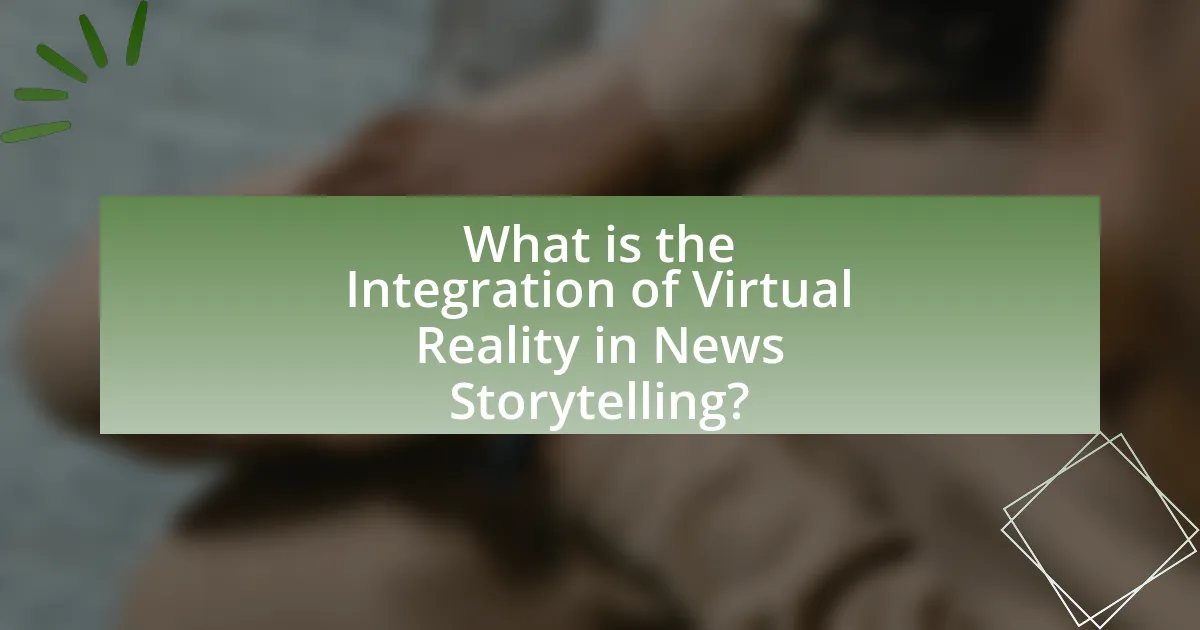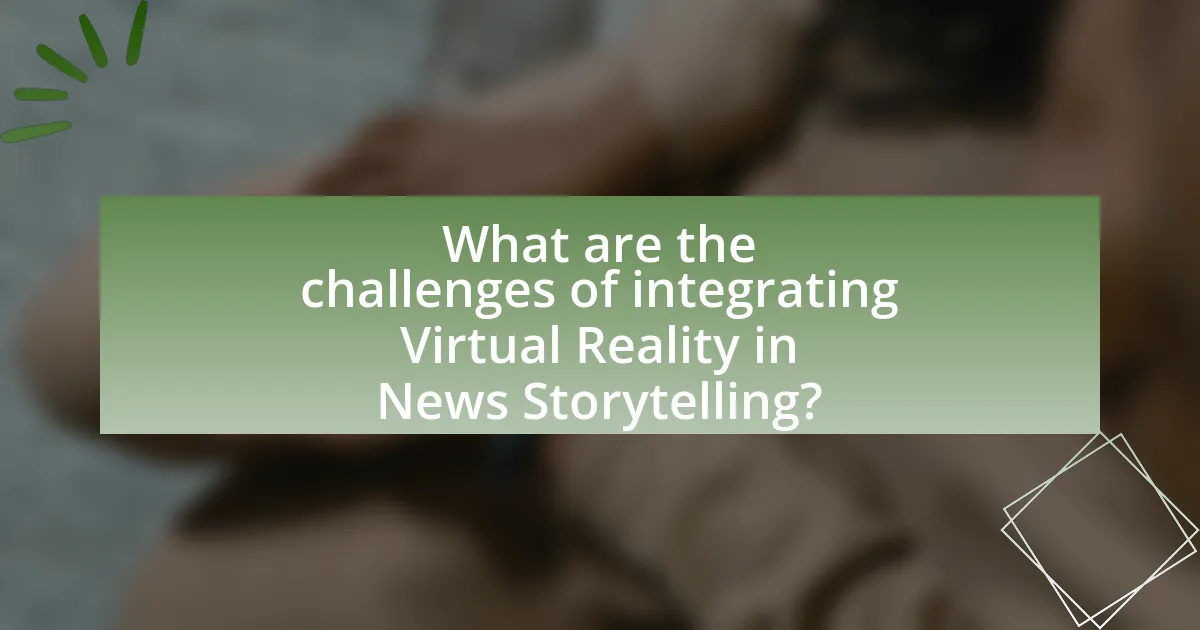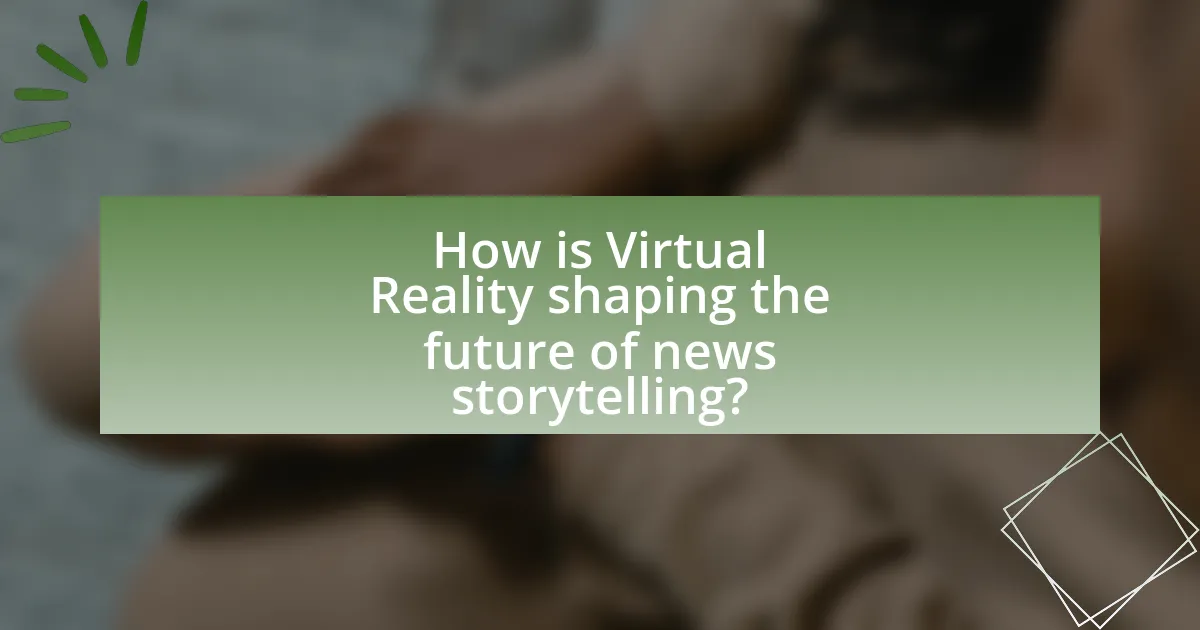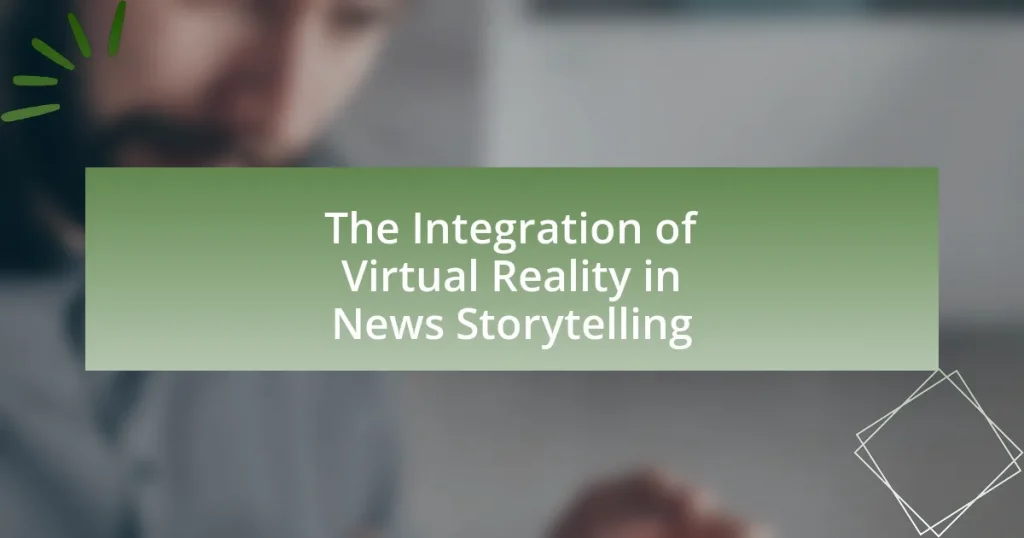The integration of Virtual Reality (VR) in news storytelling significantly enhances audience engagement by providing immersive experiences that allow viewers to feel present in news events. This article explores how VR transforms traditional journalism through immersive storytelling, emotional connection, and interactive elements, ultimately fostering empathy and understanding of complex issues. Key features such as real-time data visualization and the ability to experience events from a first-person perspective are discussed, alongside the challenges of high production costs, technical barriers, and ethical considerations. Additionally, the article examines audience expectations and the trends driving the adoption of VR in journalism, highlighting innovative examples and best practices for effective implementation.

What is the Integration of Virtual Reality in News Storytelling?
The integration of virtual reality in news storytelling enhances audience engagement by providing immersive experiences that allow viewers to feel present in the news events. This technology enables journalists to create 360-degree videos and interactive environments, which can convey complex stories more effectively than traditional media. For instance, a report by the Pew Research Center in 2020 highlighted that immersive storytelling through virtual reality can lead to increased empathy and understanding of global issues, as users can experience situations from the perspective of those affected.
How does Virtual Reality enhance traditional news storytelling?
Virtual Reality enhances traditional news storytelling by immersing audiences in a three-dimensional environment that allows for a more engaging and interactive experience. This immersive quality enables viewers to feel as though they are part of the story, fostering a deeper emotional connection to the content. For instance, studies have shown that VR can increase empathy and understanding of complex issues, as seen in projects like “The Displaced,” which places viewers in the shoes of refugee children. By providing a first-person perspective, VR transforms passive consumption of news into an active experience, thereby enhancing retention and impact.
What are the key features of Virtual Reality that benefit news reporting?
The key features of Virtual Reality that benefit news reporting include immersive storytelling, enhanced audience engagement, and real-time data visualization. Immersive storytelling allows viewers to experience news events as if they are physically present, fostering a deeper emotional connection to the content. Enhanced audience engagement is achieved through interactive elements that encourage viewers to explore stories at their own pace, leading to increased retention of information. Real-time data visualization enables journalists to present complex information in an easily digestible format, making it more accessible to the audience. These features collectively transform traditional news reporting into a more impactful and informative experience.
How does immersion in Virtual Reality change audience perception of news?
Immersion in Virtual Reality significantly alters audience perception of news by enhancing emotional engagement and fostering a sense of presence. Research indicates that immersive experiences can lead to stronger emotional responses, making viewers more empathetic towards the subjects of news stories. For instance, a study published in the journal “Computers in Human Behavior” by Bailenson et al. (2008) found that participants who experienced news in a virtual environment reported higher levels of emotional involvement compared to traditional media formats. This heightened emotional connection can influence how audiences interpret and retain information, ultimately shaping their understanding of complex issues.
Why is Virtual Reality becoming important in the news industry?
Virtual Reality is becoming important in the news industry because it enhances immersive storytelling, allowing audiences to experience news events in a more engaging and impactful way. This technology enables viewers to feel as though they are present at the scene of events, which can lead to a deeper emotional connection and understanding of the news. For instance, news organizations like The New York Times and BBC have utilized VR to cover significant events, such as the Syrian refugee crisis, providing users with a first-person perspective that traditional media cannot offer. This shift towards immersive experiences is supported by research indicating that immersive storytelling can increase empathy and retention of information among viewers, making VR a valuable tool for modern journalism.
What trends are driving the adoption of Virtual Reality in journalism?
The adoption of Virtual Reality in journalism is primarily driven by the demand for immersive storytelling experiences. This trend is fueled by advancements in VR technology, which enhance user engagement and emotional connection to news stories. According to a 2021 report by the Pew Research Center, 59% of journalists believe that VR can provide a more impactful way to convey complex issues, allowing audiences to experience events from a first-person perspective. Additionally, the increasing accessibility of VR devices and platforms has made it easier for news organizations to produce and distribute VR content, further accelerating its integration into journalism.
How do audience expectations influence the integration of Virtual Reality in news?
Audience expectations significantly influence the integration of Virtual Reality (VR) in news by shaping the demand for immersive storytelling experiences. As audiences increasingly seek engaging and interactive content, news organizations are compelled to adopt VR technologies to meet these expectations. Research indicates that 70% of consumers prefer news that offers a more immersive experience, prompting media outlets to explore VR as a means to enhance viewer engagement and emotional connection with stories. This shift is evident in the growing number of VR news projects launched by major networks, which aim to provide a more impactful narrative by allowing audiences to experience events from a first-person perspective.

What are the challenges of integrating Virtual Reality in News Storytelling?
The challenges of integrating Virtual Reality in news storytelling include high production costs, technical limitations, and audience accessibility issues. High production costs arise from the need for specialized equipment and skilled personnel to create immersive content, which can strain budgets for news organizations. Technical limitations, such as the requirement for advanced hardware and software, can hinder the widespread adoption of VR in journalism. Additionally, audience accessibility issues stem from the fact that not all viewers have access to VR headsets or the necessary technology, limiting the reach of VR news stories. These challenges collectively impede the effective implementation of Virtual Reality in the news industry.
What technical barriers exist for news organizations adopting Virtual Reality?
News organizations face several technical barriers when adopting Virtual Reality (VR), including high production costs, limited access to VR hardware, and a lack of skilled personnel. High production costs stem from the need for specialized equipment and software, which can be prohibitively expensive for many organizations. Limited access to VR hardware restricts the ability to create and distribute content effectively, as not all audiences possess the necessary devices to experience VR. Additionally, the lack of skilled personnel, such as VR developers and content creators, hampers the ability to produce high-quality VR experiences. These barriers collectively hinder the widespread integration of VR in news storytelling.
How do costs impact the implementation of Virtual Reality in newsrooms?
Costs significantly impact the implementation of Virtual Reality (VR) in newsrooms by determining the feasibility and scale of VR projects. High initial investments in VR technology, including hardware, software, and training, can limit the ability of news organizations to adopt VR effectively. For instance, a report by the International News Media Association indicates that the average cost of VR equipment can exceed $10,000, which poses a barrier for smaller newsrooms with limited budgets. Additionally, ongoing costs related to content creation and maintenance further complicate the financial landscape, as producing high-quality VR content often requires specialized skills and resources. Consequently, these financial constraints can lead to a slower adoption rate of VR technologies in the news industry, impacting the overall innovation and storytelling capabilities of news organizations.
What skills are required for journalists to effectively use Virtual Reality?
Journalists require technical proficiency, storytelling ability, and an understanding of immersive experiences to effectively use Virtual Reality. Technical proficiency involves familiarity with VR hardware and software, enabling journalists to create and edit VR content. Storytelling ability is crucial, as journalists must craft narratives that engage audiences in a three-dimensional space, enhancing emotional connection and immersion. Understanding immersive experiences allows journalists to design content that leverages VR’s unique capabilities, such as spatial audio and interactive elements, to convey news stories more compellingly. These skills collectively enhance the effectiveness of VR in news storytelling, making it a powerful tool for engaging audiences.
What ethical considerations arise with the use of Virtual Reality in news?
The ethical considerations that arise with the use of Virtual Reality in news include issues of consent, representation, and the potential for misinformation. Consent is critical, as individuals depicted in VR news stories must agree to their portrayal, especially in sensitive contexts. Representation concerns arise when VR experiences may inadvertently reinforce stereotypes or misrepresent marginalized communities, impacting public perception. Additionally, the immersive nature of VR can lead to emotional manipulation, where viewers may be influenced by the emotional weight of the experience rather than objective facts, raising concerns about the accuracy and integrity of the information presented. These considerations highlight the need for ethical guidelines to ensure responsible use of VR in journalism.
How can news organizations ensure accuracy and truthfulness in Virtual Reality storytelling?
News organizations can ensure accuracy and truthfulness in Virtual Reality storytelling by implementing rigorous fact-checking protocols and collaborating with subject matter experts. These organizations should establish a multi-step verification process that includes cross-referencing information from multiple credible sources before integrating it into VR narratives. For instance, a study by the Pew Research Center highlights that 62% of Americans believe that news organizations should prioritize accuracy over speed, emphasizing the importance of thorough verification in maintaining credibility. Additionally, involving experts in relevant fields can provide insights that enhance the authenticity of the VR experience, ensuring that the representation of events is both accurate and contextually rich.
What are the potential risks of audience manipulation through Virtual Reality?
The potential risks of audience manipulation through Virtual Reality (VR) include the distortion of reality, emotional desensitization, and the reinforcement of biases. VR can create immersive experiences that may lead individuals to accept manipulated narratives as truth, as evidenced by studies showing that immersive environments can significantly alter perceptions and beliefs. For instance, research published in the journal “Virtual Reality” highlights how VR experiences can evoke strong emotional responses, which may be exploited to sway opinions or reinforce existing biases, thereby compromising the integrity of information presented in news storytelling.

How is Virtual Reality shaping the future of news storytelling?
Virtual Reality (VR) is transforming the future of news storytelling by providing immersive experiences that engage audiences on a deeper emotional level. This technology allows viewers to experience news events as if they were physically present, enhancing empathy and understanding. For instance, VR has been used in reporting on humanitarian crises, enabling users to witness the conditions faced by individuals in conflict zones, which can lead to increased awareness and action. A notable example is the VR documentary “The Displaced,” which follows the lives of children in refugee camps, illustrating the potential of VR to convey complex narratives in a compelling manner.
What innovative examples of Virtual Reality in news storytelling exist today?
Innovative examples of Virtual Reality in news storytelling today include projects like “The Displaced” by The New York Times, which immerses viewers in the lives of refugees, and “Inside the Syrian War” by Frontline, which provides a first-person perspective of conflict zones. These projects utilize VR technology to create an emotional connection and enhance understanding of complex issues, as evidenced by the positive audience engagement and critical acclaim they have received.
How have audiences responded to Virtual Reality news experiences?
Audiences have generally responded positively to Virtual Reality (VR) news experiences, appreciating the immersive nature that enhances engagement and understanding. Research indicates that VR news can evoke stronger emotional responses compared to traditional media, leading to increased empathy and retention of information. For instance, a study by the Pew Research Center found that 70% of participants felt more connected to the news story when experienced in VR, highlighting its effectiveness in storytelling. Additionally, users often report a sense of presence that traditional formats cannot replicate, making VR a compelling medium for news consumption.
What lessons can be learned from early adopters of Virtual Reality in journalism?
Early adopters of Virtual Reality in journalism demonstrate that immersive storytelling enhances audience engagement and emotional connection. For instance, projects like “The Displaced” by The New York Times allowed viewers to experience the lives of refugees, resulting in increased empathy and understanding of complex issues. Additionally, these early implementations highlight the importance of technical proficiency and narrative design, as successful VR journalism requires a balance between compelling storytelling and effective use of technology. Furthermore, feedback from audiences indicates that clarity in the VR experience is crucial; users prefer narratives that guide them through the content rather than leaving them disoriented.
What best practices should news organizations follow when integrating Virtual Reality?
News organizations should prioritize user experience, content relevance, and ethical considerations when integrating Virtual Reality. Focusing on user experience involves creating immersive environments that enhance storytelling without overwhelming the audience. Content relevance ensures that VR experiences are directly tied to the news narrative, making them meaningful and engaging. Ethical considerations include transparency about the use of VR, ensuring that representations are accurate and do not mislead viewers. For instance, the BBC’s use of VR in its coverage of the Syrian conflict effectively illustrated the human impact of war, demonstrating how immersive storytelling can foster empathy and understanding.
How can newsrooms effectively train staff for Virtual Reality storytelling?
Newsrooms can effectively train staff for Virtual Reality storytelling by implementing hands-on workshops that focus on both technical skills and narrative techniques specific to VR. These workshops should include practical sessions on using VR equipment, software for creating immersive content, and storytelling frameworks that leverage the unique aspects of VR, such as spatial awareness and interactivity.
Research indicates that immersive training environments enhance learning outcomes; for instance, a study by the University of Maryland found that participants in VR training scenarios performed better in real-world tasks compared to traditional training methods. By incorporating such evidence-based practices, newsrooms can ensure that their staff not only understand the technology but also how to engage audiences effectively through immersive storytelling.
What strategies can enhance audience engagement with Virtual Reality news content?
Interactive storytelling techniques can significantly enhance audience engagement with Virtual Reality news content. By allowing users to make choices that influence the narrative, such as selecting different perspectives or exploring various storylines, the immersive experience becomes more personalized and captivating. Research indicates that interactive elements can increase viewer retention and emotional connection, as evidenced by a study published in the Journal of Media Psychology, which found that participants reported higher engagement levels when they could interact with the content. Additionally, incorporating real-time data visualization within the VR environment can provide viewers with a deeper understanding of complex news topics, further enhancing their engagement.




